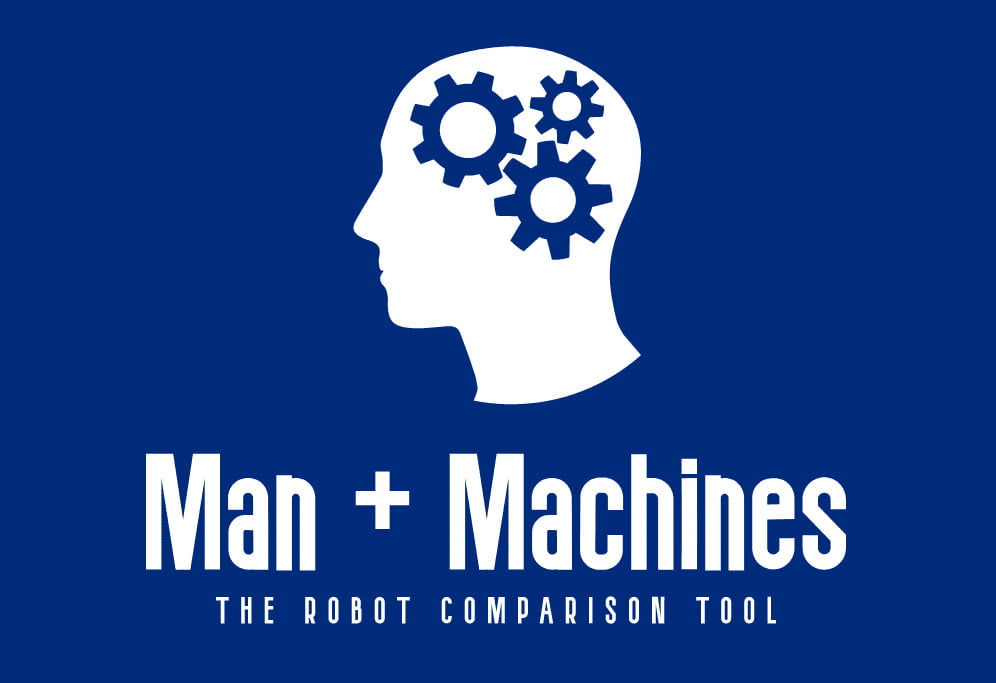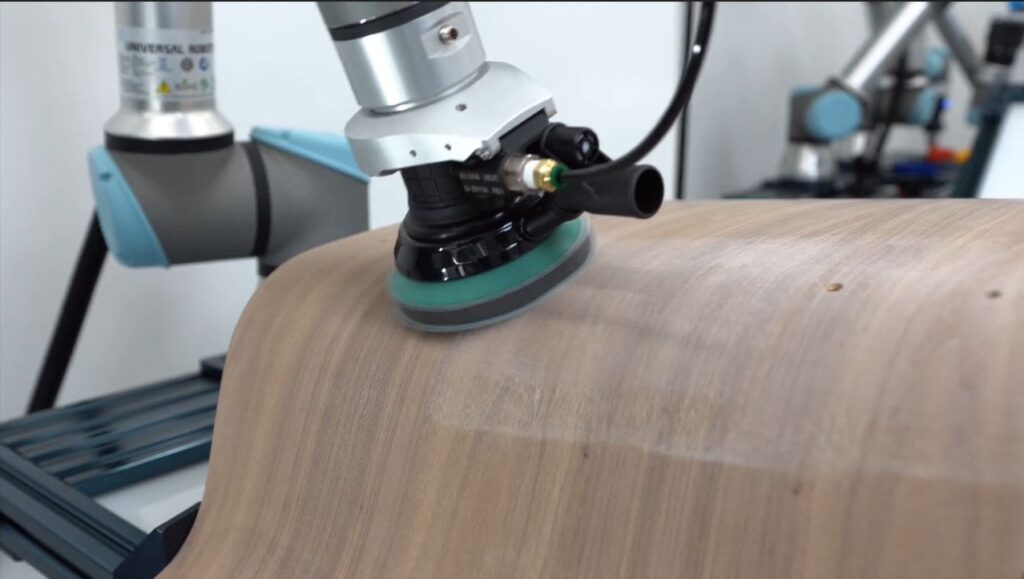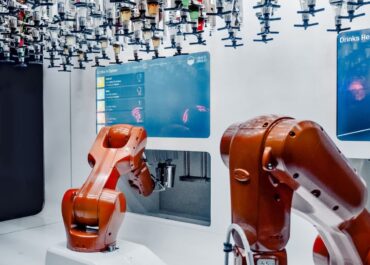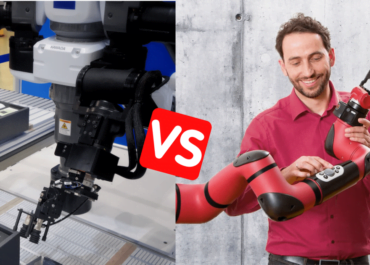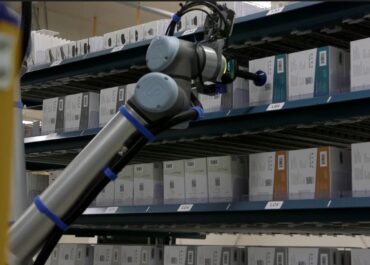Due to their agility and versatility, cobots have a wide range of applications compared to standard industrial robots. They can handle a variety of tools and objects and be deployed in many environments.
The automation opportunities are therefore endless for industries, and are only limited to the imagination of plant managers. But non-industrial sectors can also benefit from more original and innovative applications.
Here is a guide to the tasks and processes where cobots can make a big difference.
Industrial-type applications
Pick & Place

Pick & place is the most standard task performed by robots. And no wonder, since it is also one of the most repetitive and tedious tasks for workers.
Being agile and easily deployable, cobots are a reliable and low-cost solution to automate these pick & place flows. They can fit on any conveyor, chain or production tray. In a few movements, employees can teach them to continuously pick up and place objects from one line to another.
For more random flows, cobots can also detect and move non-predetermined quantities and shapes of objects with their smart vision technology. By training themselves to spot specific visual patterns, they can collect any object day or night.
Thus, with cobots, manufacturers can increase both the productivity, flexibility and profitability of their production line.
Take a look at our pick-and-place application guide.
Machine tending

Whether it’s a CNC machine or a molding, milling or pressing tool, loading and unloading parts can be a tiring and dangerous task. It can be difficult for a plant manager to convince a worker to lift heavy parts all day long.
The benefit of collaborative robots is that they can pick up and put down these objects without friction and with great redundancy. A cobot is able to perform the same gesture thousands of times and therefore increases efficiency. With proven safety, workers can thus delegate this repetitive task and focus on the machine process itself.
In addition, unlike traditional automation, cobots are inexpensive and can be easily redeployed and reprogrammed on different types of machines.
Take a look at our machine-tending collaborative application guide.
Assembly

Assembly can involve different kinds and quantities of parts, whether they are electronic, plastic, metal or wood parts. In addition, it involves a meticulous and very precise process. That’s why this task has often eluded traditional automation.
But collaborative robots are changing the game with their great agility and versatility. With a variety of gripping tools, they can adapt to any shape and size of object. They are also easily reprogrammed and redeployed by workers on new processes. They can even use their smart vision to autonomously locate and assemble different design patterns.
With high redundancy and input quality, they allow factories to improve their assembly flow and adapt to ever-evolving demand.
Welding

Among all the industrial tasks, welding is certainly one of the most dangerous. A worker who welds parts together exposes himself to risks such as burns, splashes, cuts and electrocution. For this reason, many industries have already partially or fully automated their welding process.
However, these industrial welding robots are not without shortcomings. They often cannot handle small parts, have difficulty holding them, are hard to move or repair, and need a large volume of welding to be profitable.
Collaborative robots overcome these limitations with light-weight design, flexibility and intelligence. Workers can quickly teach cobots specific welding applications, have them work on more detailed parts, and redeploy them to other shops.
While these cobots may not perform better than standard robots on high volumes, they differentiate themselves by high consistency and quality of work. With cobots, manufacturers ensure that they reduce their output costs and that their professional welders can focus on higher-value parts.
Take a look at our welding collaborative application guide.
Material dispensing and painting

Dispensing, gluing or painting are industrial tasks where material optimization is essential to prevent waste. Once again, a collaborative robot makes all the difference thanks to high repeatability and precision of movement.
When taught the right movements, they can apply materials and liquids on surfaces with great efficiency. They can also be quickly reprogrammed to work on other types of surfaces.
Meanwhile, workers can check the result, keep improving the process and reprogram the robots for new tasks.
Take a look at our dispensing collaborative application guide.
Quality inspection

Thanks to computer vision and 3D measurement tools, modern cobot models can also handle repetitive quality inspection processes. When it comes to checking a screw, a wire or measuring the weight or shape of an object, they can follow very precise inspection processes with little deviation. They provide flawless objectivity that improves the quality and reliability of your products.
You can also assign them to other quality processes without any problem, and place them in more or less tighted work space. Meanwhile, workers can focus on finalizing the inspection and bringing their aesthetic judgment to the table, to make sure to get a beautiful and flawless product.
Take a look at our quality control application guide.
Packing and Palletizing

Packing and palletizing is still mostly handled by human workers, but it can also be undertaken by collaborative robots. Cobots equipped with vacuum grippers can easily pick up and place packages and products of all shapes and sizes.
With smart programming, they can easily assemble cartons and packaging containers to support the process. They can also weigh and check packages before palletizing them and delivering them to carriers.
In all of these tasks, manufacturers gain productivity and ensure reliable, high-quality packaging. They also provide their employees with a reliable and efficient companion to ease their workload.
Take a look at our palletizing collaborative application guide.
Finishing

Proficient sanding, polishing, grinding or even buffing processes depends largely on the force applied. And people often feel like cobots cannot achieve this since they don’t have the strength of a standard industrial robot.
However, this is a wrong misconception. Cobots are perfectly capable of applying great and consistent strenght to work surfaces. When equipped with appropriate finishing tools and well programmed, they can polish and sand progressively and delicately wood, fiberglass, plastic surfaces…
Meanwhile, finishing experts can save time to process more sophisticated parts. They can also easily assist cobots and teach them the right gesture in complete safety.
Take a look at our sanding collaborative application guide.
Transporting

In recent years, more mobile and transportation-oriented cobot models have emerged on the market. As they are equipped with wheels or chains, they can move and find their way in factory floors to deliver pallets or parts to the right location.
With smart vision and sensors, they move autonomously and prevent collisions with passers-by. To calibrate the destination and trajectory of their path, they are easily programmable with an intuitive interface.
As a result, they free workers from the task of pushing heavy or light loads to distant production lines. They save time on their movement and allow them to focus on the tasks at hand.
Non-industrial applications
Cooking

The applications of collaborative robots do not stop at the factory gate. They are especially starting to find their way in back kitchens to assist restaurants at the cutting edge of new technologies. They can, for example, handle molding pastries or managing food stocks.
The company Miso Robotics goes even further, designing a frying cobot, Flippy, which can cook meats and fries with optimal timing. Flippy can detect different types of food and flip them according to the cooking order.
Harvesting & milking

Agriculture is one of the last sectors to embrace cobotics. Yet, from sowing seeds, to tending and harvesting fruit, there are many opportunities to use cobots to automate repetitive and tiring tasks.
Cobots have a delicate touch and can handle agricultural products without worry. This also works on dairy products, as cobots can gently care for and handle animals. As in this example of a cobot milking cows on an American farm.
Serving drinks

Some bars and cafés are also taking advantage of collaborative robots to serve and amaze customers. Preparing and serving drinks is often quite repetitive. But it’s within reach of the agile arms of cobots.
This allows them to provide products with consistent quality, while entertaining customers. Like in this example of a bar in Singapore where a cobot is performing.
Teaching

Cobots are also making their way into training meetings and classrooms. Some smaller, user-friendly models like Nyrio’s Ned or Dobot Magician make automation accessible to the beginners.
Learners can perform small exercises by programming with an intuitive coding interface. They can also put into practice the knowledge and theoretical notions they have learned in science courses by automating experiments.
As you can see, cobots have many talents, so up to you to find the best application for your business or need!
